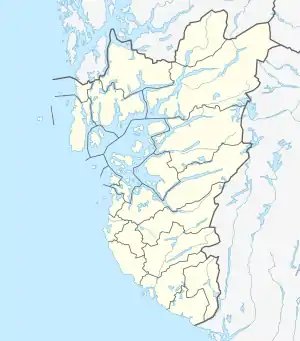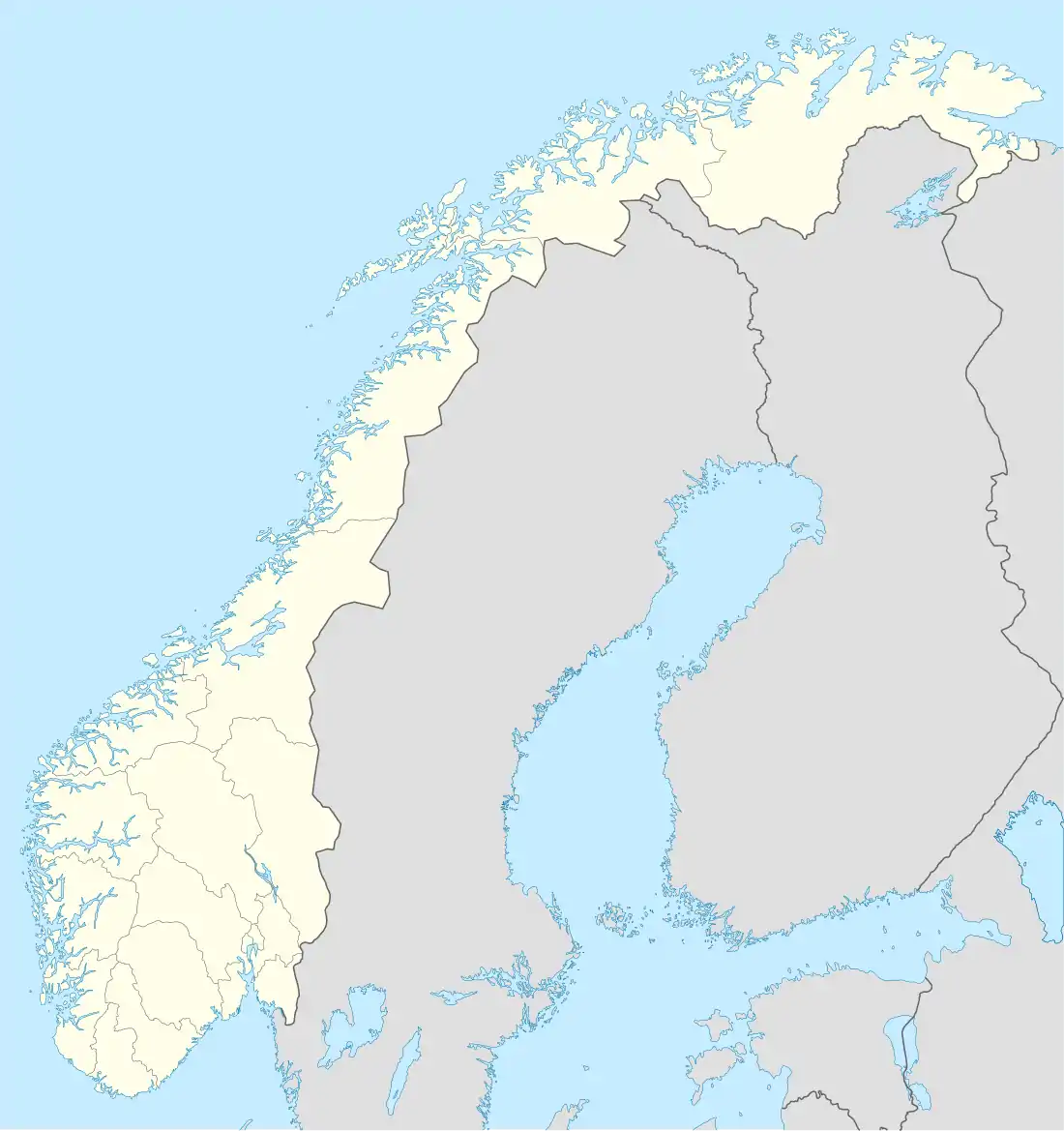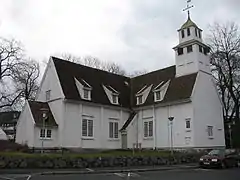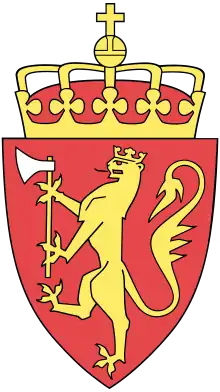Egersund
Egersund is a town in Eigersund municipality in Rogaland county, Norway. The town is located along the southwestern coast of Norway, about 75 kilometres (47 mi) south of the city of Stavanger. The town is situated along a strait which separates the mainland from the island of Eigerøya. From 1838 until 1964, the town was also an independent municipality.[4]
Egersund | |||||||||||||||||||||||||||||||
|---|---|---|---|---|---|---|---|---|---|---|---|---|---|---|---|---|---|---|---|---|---|---|---|---|---|---|---|---|---|---|---|
 View of the town | |||||||||||||||||||||||||||||||
 Egersund Location of the town  Egersund Egersund (Norway) | |||||||||||||||||||||||||||||||
| Coordinates: 58.4497°N 6.0087°E | |||||||||||||||||||||||||||||||
| Country | Norway | ||||||||||||||||||||||||||||||
| Region | Western Norway | ||||||||||||||||||||||||||||||
| County | Rogaland | ||||||||||||||||||||||||||||||
| District | Dalane | ||||||||||||||||||||||||||||||
| Municipality | Eigersund Municipality | ||||||||||||||||||||||||||||||
| Established as | |||||||||||||||||||||||||||||||
| Ladested | 18 July 1798 | ||||||||||||||||||||||||||||||
| Area | |||||||||||||||||||||||||||||||
| • Total | 6.79 km2 (2.62 sq mi) | ||||||||||||||||||||||||||||||
| Elevation | 57 m (187 ft) | ||||||||||||||||||||||||||||||
| Population (2019)[1] | |||||||||||||||||||||||||||||||
| • Total | 11,433 | ||||||||||||||||||||||||||||||
| • Density | 1,684/km2 (4,360/sq mi) | ||||||||||||||||||||||||||||||
| Demonym(s) | Egersundar | ||||||||||||||||||||||||||||||
| Time zone | UTC+01:00 (CET) | ||||||||||||||||||||||||||||||
| • Summer (DST) | UTC+02:00 (CEST) | ||||||||||||||||||||||||||||||
| Post Code | 4370 Egersund
| ||||||||||||||||||||||||||||||
The 6.79-square-kilometre (1,680-acre) town has a population (2019) of 11,433 and a population density of 1,684 inhabitants per square kilometre (4,360/sq mi).[1]
Egersund has one of the best natural harbours in Norway, and it used to be the largest harbour in Norway when measured in quantity of fish brought in each year (surpassed by Ålesund in 2006). Several internationally known companies have divisions here, like Navico (earlier Robertson autopilots) and Jeppesen Norway formerly C-MAP Norway (producer of electronic sea-maps). In addition, the Aker Solutions corporation owns and runs a large installation here which specializes in the building of parts for oil platforms. Most of the industry is related to the sea and to boats.[4]
History
Early history
People have lived around the area of Egersund since the Stone Age. There are several places around Egersund where one can find ruins of settlements dating back to the age of migrations in Norway (400–600 BC).
Middle Ages
There used to be a church here, the Church of St. Mary, mentioned in 1292 in a privilege of indulgence issued in Rome on 5 February 1292 by Pope Nicholas IV as Ecclesia beatæ Mariæ de Eikundarsund. It was the first church in Egersund, and was the parish church of the St. Mary parish. It is believed to have been located where the present Egersund Church stands today. Old folklore from Egersund also says that before the Church of St. Mary, an altar where people sacrificed to the old Norse gods was placed here, but this has not been verified from any sources except old stories.
There was also a chapel, the chapel of St. Laurenti, mentioned in a letter issued on 5 February 1308 as Ecclesia beati Laurentii de Eikundarsund, where Pope Clement V gives King Håkon V Magnusson extensive privileges concerning the King's 14 chapels (including the chapel of St. Laurenti), which was founded by himself or his father, King Magnus Lagabøte, and his grandfather, King Håkon Håkonson. Since these chapels often were built on the king's estates, it is presumed to have been on grounds owned by the Husaby estate. An old tradition says it was located at what is now "Strandgata 43", but the exact position is somewhat uncertain.
17th and 18th centuries

In 1623 the old church (probably the Church of St. Mary) was demolished and a new Egersund Church was erected. This wooden still stands today.
On 18 July 1798, the village of Egersund was established as a ladested with its own Customs office.
19th and 20th centuries
The ladested of Egersund was established as a municipality on 1 January 1838 under the new formannskapsdistrikt law. This effectively gave Egersund the municipal self-government that was now uniformly given to all areas of Norway.[5]
In 1843, a fire destroyed two thirds of the town, allowing a major redesign of streets. In 1847, Johan Feyer founded A/S Egersunds Fayancefabriks Co., which became the town's major employer until closing in 1979.
On 7 July 1859, there was another major fire and then again on 20 October 1862 there was another fire. This was the last major town fire since town planners finally understood wooden structures' vulnerability and reconstructed using extra wide streets to prevent fires from spreading.
In 1878, the Jærensbanen railway line between Egersund and the city of Stavanger opened with Egersund Station in the centre of the town. In 1905, Egersund became the first town in Rogaland county to get electrical lighting.
On 9 April 1940, the German military invaded Norway and they occupy Egersund during World War II. Egersund had strategic importance because of its good harbour, as well as because the telegraph line between Norway and England was situated there. The Germans built large camps in the area. The occupation lasted until the end of the war.
In 1947, the town was growing rapidly, and an area of the neighboring municipality of Eigersund (population: 515) was transferred into the town of Egersund.[5]
During the 1960s, the Schei Committee met in Norway to discuss the municipal structure in the nation. It was decided that the number of cities and municipalities in Norway was too great, so on 1 January 1965, the town of Egersund lost its status as a self-governing municipality. On that date, the following places were all merged into the new, larger municipality of Eigersund, with the town of Egersund as the new administrative centre:[5]
Name
The name "Egersund" derives from the Old Norse name for the strait between Eigerøya and the mainland, which was called Eikundarsund. The name of Eigerøy (Old Norse: Eikund) comes from the rich deposits of oak trees since the word eik is the Norwegian word for "oak". The name is among the oldest place names in Norway. It can already be found in the form Eikundarsund in the Norse saga of Olav the Holy, written by Icelandic author Snorri Sturlasson in the 13th century. From around the year 1000 Olav the Holy's fleet was here often. We can also find the name in texts and scaldic poems from Olav's saga.
Government
From 1838 until 1964 when the town of Egersund was an independent municipality, it was responsible for primary education (through 10th grade), outpatient health services, senior citizen services, unemployment and other social services, zoning, economic development, and municipal roads. The municipality was governed by a municipal council of elected representatives, which in turn elects a mayor.[6]
Municipal council
The municipal council (Bystyre) of Egersund was made up of representatives that were elected to four year terms. The party breakdown of the final municipal council was as follows:
| Party Name (in Norwegian) | Number of representatives | |
|---|---|---|
| Labour Party (Arbeiderpartiet) | 13 | |
| Conservative Party (Høyre) | 7 | |
| Christian Democratic Party (Kristelig Folkeparti) | 5 | |
| Liberal Party (Venstre) | 4 | |
| Total number of members: | 29 | |
| Party Name (in Norwegian) | Number of representatives | |
|---|---|---|
| Labour Party (Arbeiderpartiet) | 13 | |
| Conservative Party (Høyre) | 6 | |
| Communist Party (Kommunistiske Parti) | 1 | |
| Christian Democratic Party (Kristelig Folkeparti) | 5 | |
| Liberal Party (Venstre) | 4 | |
| Total number of members: | 29 | |
| Party Name (in Norwegian) | Number of representatives | |
|---|---|---|
| Labour Party (Arbeiderpartiet) | 13 | |
| Conservative Party (Høyre) | 6 | |
| Communist Party (Kommunistiske Parti) | 1 | |
| Christian Democratic Party (Kristelig Folkeparti) | 6 | |
| Liberal Party (Venstre) | 3 | |
| Total number of members: | 29 | |
| Party Name (in Norwegian) | Number of representatives | |
|---|---|---|
| Labour Party (Arbeiderpartiet) | 12 | |
| Conservative Party (Høyre) | 5 | |
| Communist Party (Kommunistiske Parti) | 1 | |
| Christian Democratic Party (Kristelig Folkeparti) | 6 | |
| Liberal Party (Venstre) | 4 | |
| Total number of members: | 28 | |
| Party Name (in Norwegian) | Number of representatives | |
|---|---|---|
| Labour Party (Arbeiderpartiet) | 13 | |
| Communist Party (Kommunistiske Parti) | 3 | |
| Christian Democratic Party (Kristelig Folkeparti) | 7 | |
| Joint list of the Liberal Party (Venstre) and the Radical People's Party (Radikale Folkepartiet) | 5 | |
| Total number of members: | 28 | |
| Note: The Conservative Party originally had enough votes to earn 6 representatives but the Ministry of Justice rejected all those votes due to an error in the original election list. | ||
| Party Name (in Norwegian) | Number of representatives | |
|---|---|---|
| Labour Party (Arbeiderpartiet) | 12 | |
| Conservative Party (Høyre) | 5 | |
| Communist Party (Kommunistiske Parti) | 3 | |
| Christian Democratic Party (Kristelig Folkeparti) | 4 | |
| Joint list of the Liberal Party (Venstre) and the Radical People's Party (Radikale Folkepartiet) | 3 | |
| Local List(s) (Lokale lister) | 1 | |
| Total number of members: | 28 | |
| Party Name (in Norwegian) | Number of representatives | |
|---|---|---|
| Labour Party (Arbeiderpartiet) | 6 | |
| Temperance Party (Avholdspartiet) | 8 | |
| Conservative Party (Høyre) | 7 | |
| Communist Party (Kommunistiske Parti) | 2 | |
| Liberal Party (Venstre) | 5 | |
| Total number of members: | 28 | |
| Party Name (in Norwegian) | Number of representatives | |
|---|---|---|
| Labour Party (Arbeiderpartiet) | 5 | |
| Temperance Party (Avholdspartiet) | 10 | |
| Conservative Party (Høyre) | 6 | |
| Communist Party (Kommunistiske Parti) | 1 | |
| Liberal Party (Venstre) | 6 | |
| Total number of members: | 28 | |
| Party Name (in Norwegian) | Number of representatives | |
|---|---|---|
| Labour Party (Arbeiderpartiet) | 5 | |
| Temperance Party (Avholdspartiet) | 11 | |
| Communist Party (Kommunistiske Parti) | 1 | |
| Liberal Party (Venstre) | 5 | |
| Joint list of the Conservative Party (Høyre) and the Free-minded People's Party (Frisinnede Folkeparti) | 6 | |
| Total number of members: | 28 | |
| Party Name (in Norwegian) | Number of representatives | |
|---|---|---|
| Labour Party (Arbeiderpartiet) | 7 | |
| Temperance Party (Avholdspartiet) | 9 | |
| Communist Party (Kommunistiske Parti) | 1 | |
| Liberal Party (Venstre) | 4 | |
| Joint list of the Conservative Party (Høyre) and the Free-minded Liberal Party (Frisinnede Venstre) | 7 | |
| Total number of members: | 28 | |
| Party Name (in Norwegian) | Number of representatives | |
|---|---|---|
| Labour Party (Arbeiderpartiet) | 1 | |
| Temperance Party (Avholdspartiet) | 9 | |
| Social Democratic Labour Party (Socialdemokratiske Arbeiderparti) | 6 | |
| Liberal Party (Venstre) | 4 | |
| Joint list of the Conservative Party (Høyre) and the Free-minded Liberal Party (Frisinnede Venstre) | 7 | |
| Workers' Common List (Arbeidernes fellesliste) | 1 | |
| Total number of members: | 28 | |
| Party Name (in Norwegian) | Number of representatives | |
|---|---|---|
| Labour Party (Arbeiderpartiet) | 3 | |
| Temperance Party (Avholdspartiet) | 10 | |
| Conservative Party (Høyre) | 6 | |
| Social Democratic Labour Party (Socialdemokratiske Arbeiderparti) | 5 | |
| Liberal Party (Venstre) | 4 | |
| Total number of members: | 28 | |
| Party Name (in Norwegian) | Number of representatives | |
|---|---|---|
| Labour Party (Arbeiderpartiet) | 5 | |
| Temperance Party (Avholdspartiet) | 11 | |
| Conservative Party (Høyre) | 8 | |
| Liberal Party (Venstre) | 4 | |
| Total number of members: | 28 | |
Transportation
Egersund has good connections by road to the cities of Stavanger and Kristiansand, via the European route E39 highway. There is also a more scenic coastal highway Norwegian County Road 44. There is an hourly train connections northwards to Stavanger, while express and regional trains run southwards towards Kristiansand and Oslo.
Neighborhoods
Egersund is divided up into several neighborhoods
- Central (the central part of the town) It is further divided into:
- Damsgård, Havsøyne, Husabø, Lervige, Mosbekk, Årstad, Årstaddalen
- Hestnes (far south part of the town)
- Lagård (along the lake)
- Rundevoll (central-south part of the town)
- Sandbakkan (far southeastern part of the town)
- Slettebø (far northeastern part of the town)
- Søra Eigerøy / Søra Øyne (the south part of the island of Eigerøya)
- Norda Eigerøy / Nora Øyne (the north part of the island of Eigerøya)
- Tengs (far northwestern part of the town)
- Åsan (near the bridge to Eigerøya)
Attractions
- Dalane Folkemuseum: Museum of antiquities and history of Egersund.
- Egersund Fayancemuseum: Museum of the glazed earthenware and porcelain made by Egersund Fayancefabrik from 1847 till 1979.
- «Stoplesteinan». A rather unknown attraction, since it has not been embraced by the local tourist bureau. «Stoplesteinan» is a smaller «Stonehenge», i.e. a stone circle. It is more than a thousand years old, and believed by some to be almost 2000 years old. Who built it and why, is unknown. The stone circle is situated directly above Skårabrekkå just outside downtown Egersund.
- Central Egersund houses some of the best preserved wood buildings in Norway. They are built in late Empire style, and most of the buildings are protected by law.
- Magma UNESCO Global Geopark: open air geological park provided with facilities for outdoor activities to discover the amazing geological heritage of the area. From November 2017 in Egersund headquarter will be open to the public the geoVR virtual exhibition.
- Home to the popular Trollpikken rock formation.
Notable residents
- Øystein Aarseth (1968–1993) Lead guitarist and founder of pioneering Black Metal band Mayhem.
- Peter C. Assersen (1839–1906), Rear Admiral in the United States Navy
- Johan Lædre Bjørdal, Footballer
- Anna Bugge (1862–1928), feminist and Swedish diplomat in Geneva (Switzerland)
- Elizabeth Fedde (1850–1921), deaconess, hospital founder, honored on the Lutheran Church calendar
- Gunnar Kvassheim, Politician
- Bengt Sæternes, Former footballer
- Kai Ove Stokkeland, Captain at Bryne Football team
- Jørgen Tengesdal, Former footballe
- Jacob Thorkelson, Member of the United States House of Representatives.
References
- Statistisk sentralbyrå (1 January 2019). "Urban settlements. Population and area, by municipality".
- "Egersund, Eigersund (Rogaland)". yr.no. Retrieved 12 July 2020.
- "Navn på steder og personer: Innbyggjarnamn" (in Norwegian). Språkrådet.
- Store norske leksikon. "Egersund" (in Norwegian). Retrieved 28 June 2016.
- Jukvam, Dag (1999). "Historisk oversikt over endringer i kommune- og fylkesinndelingen" (PDF) (in Norwegian). Statistisk sentralbyrå.
- Hansen, Tore, ed. (12 May 2016). "kommunestyre". Store norske leksikon (in Norwegian). Kunnskapsforlaget. Retrieved 13 July 2020.
- "Kommunevalgene 1963" (PDF) (in Norwegian). Oslo: Statistisk sentralbyrå. 1964. Retrieved 2 August 2020.
- "Kommunevalgene og Ordførervalgene 1959" (PDF) (in Norwegian). Oslo: Statistisk sentralbyrå. 1960. Retrieved 2 August 2020.
- "Kommunevalgene og Ordførervalgene 1955" (PDF) (in Norwegian). Oslo: Statistisk sentralbyrå. 1957. Retrieved 2 August 2020.
- "Kommunevalgene og Ordførervalgene 1951" (PDF) (in Norwegian). Oslo: Statistisk sentralbyrå. 1952. Retrieved 2 August 2020.
- "Kommunevalgene og Ordførervalgene 1947" (PDF) (in Norwegian). Oslo: Statistisk sentralbyrå. 1948. Retrieved 2 August 2020.
- "Kommunevalgene og Ordførervalgene 1945" (PDF) (in Norwegian). Oslo: Statistisk sentralbyrå. 1947. Retrieved 2 August 2020.
- "Kommunevalgene og Ordførervalgene 1937" (PDF) (in Norwegian). Oslo: Statistisk sentralbyrå. 1938. Retrieved 2 August 2020.
- "Kommunevalgene og Ordførervalgene 1934" (PDF) (in Norwegian). Oslo: Statistisk sentralbyrå. 1935. Retrieved 2 August 2020.
- "Kommunevalgene og Ordførervalgene 1931" (PDF) (in Norwegian). Oslo: Statistisk sentralbyrå. 1932. Retrieved 2 August 2020.
- "Kommunevalgene og Ordførervalgene 1928" (PDF) (in Norwegian). Oslo: Statistisk sentralbyrå. 1929. Retrieved 31 July 2020.
- "Kommunevalgene og Ordførervalgene 1925" (PDF) (in Norwegian). Oslo: Statistisk sentralbyrå. 1926. Retrieved 31 July 2020.
- "Kommunevalgene og Ordførervalgene 1922" (PDF) (in Norwegian). Oslo: Statistisk sentralbyrå. 1923. Retrieved 31 July 2020.
- "Kommunevalgene og Ordførervalgene 1919" (PDF) (in Norwegian). Oslo: Statistisk sentralbyrå. 1920. Retrieved 31 July 2020.



